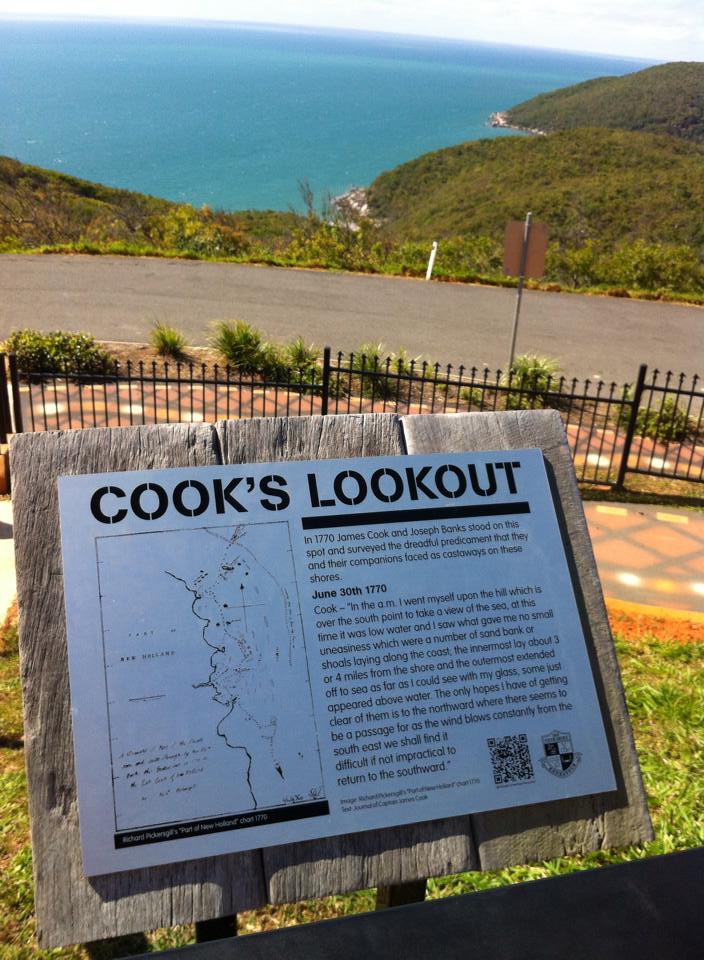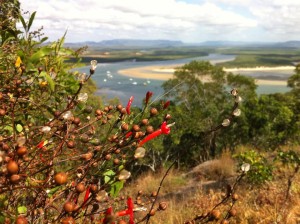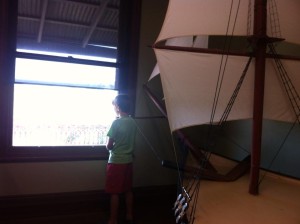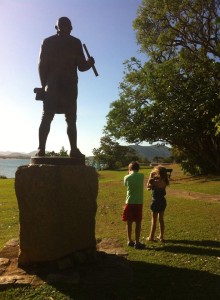Cooktown is a hybrid of frontier living, and pilgrimage destination for travellers connecting the Australian history dots. It’s also the launching pad for many heading off yonder towards Cape York, ”Ya going to the tip?” being the constant question to travellers. Sadly for us this is about as far up as we’ll go, as we ponder what brought James Cook this far himself?
But we’re pretty enamoured with what we are seeing as we cruise down the Main Street, riding in the slipstream of a fella in his motorised wheelchair. You gotta love Cooktown.
So did Cook. In the year 1770, James Cook discovered a safe river to seek shelter and repair the damage done to his ship, the Endeavour, after running aground on the Great Barrier Reef.
But there wasn’t a town here then, nor were there the other traditions which go hand-in-hand with Cooktown’s sleepy, frontier town living.
In Cooktown you “do a wharfie”
This involves cruising in your car down to one of its jetties…and you probably should also throw in a hand line to catch dinner while you are at it.
In Cooktown you “go up the hill”.
Grassy Hill with its little lighthouse and serpent pathway afforded us a birds-eye view of the lay of the land, the Coral Sea, the Endeavour River and the scene that Lieutenant James Cook would have first gazed down on as he determined where to best beach the HMB Endeavour to repair it.
In Cooktown you kind of have an intimate knowledge about that bloke Cook.
You probably inherited his left over tupperware. Or his wife’s recipe for Roast Bustard.
If you were snoozing in Australian History class (and my previous blog posts on 1770) here’s the cheat sheet notes:-
In 177O Captain James Cook and his ship the Endeavour ran afoul of the Great Barrier Reef and seriously damaged the hull. To avoid sinking, over 500 tonnes of stores had to be off-loaded in order to free the Endeavour from the reef.
When you consider Cook was steering a 368 tonne damaged vessel in waters he was mapping as he travelled along searching for a river to careen the boat in to repair it, well you’ve got to give the guy a few statues…and a cold beer! Fortunately Cook found salvation in what he later named the Endeavour River.
Captain Cook chased a chook all across Australia, lost his pants in the middle of France, and found them in Tasmania” – Aussie kids nursery rhyme
Here’s a few other factoids about Cooktown that I don’t recall learning in history class:-
1. The Endeavour River was the only river Captain Cook named
2. Cooktown was the location of the naming of the kangaroo….explained to Cook by the Guugu Yimithirr peoples as Gangarruu
3. His 48 day stay on the Endeavour River was his longest onshore stay for his entire voyage to find and chart the Great Southern Land
4. This stay effectively placed Cooktown in the history books as the site of first European settlement for Australia…albeit it all rather temporary
The history lesson doesn’t stop there. In fact the town is oozing with fables and facts that leave you in awe and the Squids actually connecting some of the dots.
Checking into the Cooktown Holiday Park we take a quick dip before plunging into the history of Captain Cook.
James Cook Museum was a terrific starting point. Housed in the restored Sisters of Mercy convent school which was built in 1889 and administered by the National Trust of Queensland, its $24 admission was a bargain when we you consider what we saw. Housing one of the most significant Trust collections in Australia, and opened by HRH Queen Elizabeth on her 1970 visit to Australia we were in for a treat.
The Skipper was in his “Cookaphile” element (remind me to blog about his time as one of the sailing crew from Thursday Island to Darwin on the replica of the HMB Endeavour a few years back…..or maybe I’ll have him write his first guest post himself!)
Anyhoooo, the Museum served us history on a barnacled platter.
The original HM Endeavour anchor and cannon, Cook’s diary extracts, the tree trunk that the Endeavour was tied up to (which stood until recently on the banks where local tinnies still tied up to it), stories from local aboriginal elders, the Palmer Gold Rush, the fateful tale of Mrs Watson (I won’t spoil the ending…you’ll have to read up on her yourself) … daily life in Cooktown, aboriginal artefacts, Chinese gold rush memorabilia and an insight into life in a pioneering Australian outpost.
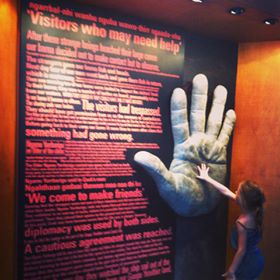
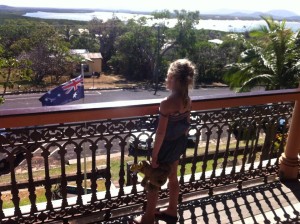
Oh, there were a few good convent living stories too…as a good Catholic girl I made sure I checked out all the prayer cards!
The Squids enjoyed blowing off steam down on the harbour.
We took in the River of Life walkway, Cook’s monuments, waving from the Queen’s steps made for HM Queen Elizabeth II for her visit to Cooktown in 1970, and checked out the James Cook monument and cairn to commemorate the man himself.
The reconciliation artwork of the Mibi Wall was equally lovely with it’s hand-painted tiles.
Also known as The Story Wall it was built by the Gungarde Aboriginal Cooperation and is a very colourful interpretation of the significance of the first known European contact with the Aboriginal People of the area from the point of view of the Guugu Yimithirr people.
The Skipper had a bit of a chuckle while standing near the Cook Monument and Cannon.
While the 1887 monument dates is impressive, the cannon was the eyebrow raiser. It was bought to Cooktown at the request of the Town Council. On 10th April 1885 a vigorous Town Council meeting resulted in the following motion:
A wire be sent to the Premier in Brisbane requesting he supply arms, ammunition and competent officers to take charge against the threat of Russian invasion”
What they got was a cannon, 3 cannonballs, 2 rifles and 1 officer. I’m sure they all slept better at night in Cooktown when the officer arrived.
I know we certainly got a good night’s sleep, but it was perhaps due to a big day soaking up history than the knowledge of border security being protected with cannon fire.
